Key takeaways:
- Anti-war activism is driven by personal experiences and a collective desire for peace, focusing on dialogue and understanding rather than just opposing conflict.
- Successful campaigns rely on clarity of message, empathy through storytelling, and strategic collaboration to amplify outreach and build community connections.
- Engaging local communities requires trust-building, open dialogue, and utilizing creative events to foster participation and address shared concerns.
- Measuring campaign success goes beyond quantitative metrics to include qualitative feedback, ensuring alignment with community needs and adjusting strategies accordingly.
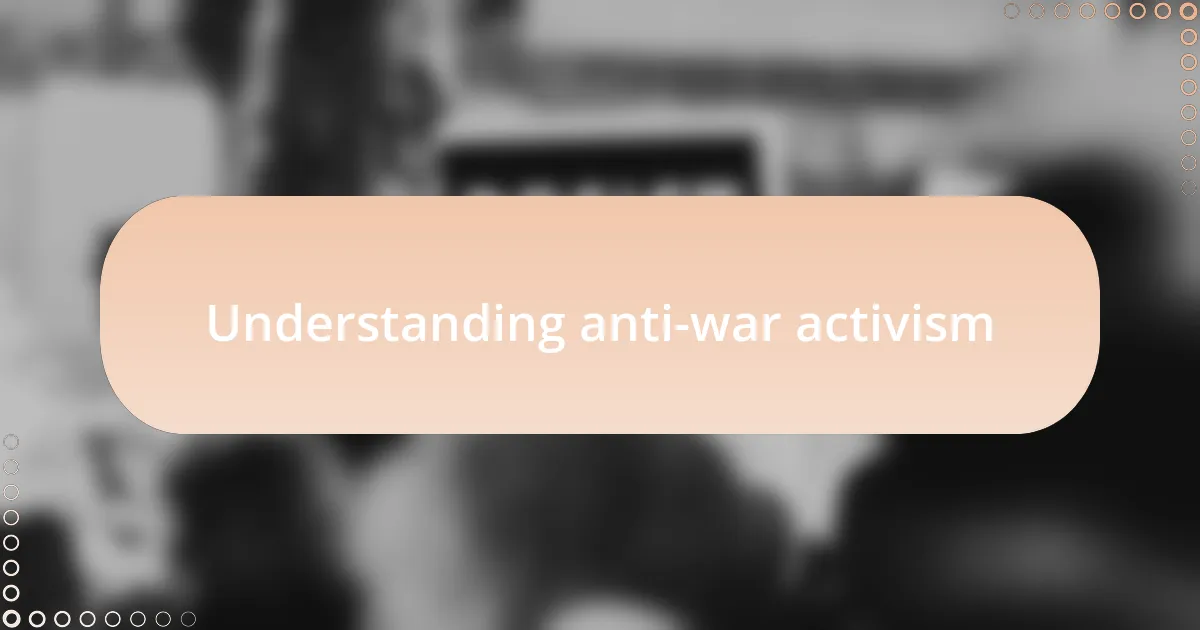
Understanding anti-war activism
Anti-war activism is a deeply personal and often emotional journey for many. I remember attending my first protest when I was in college; the energy in the air felt electric as diverse voices came together, united by a shared vision of peace. It really struck me how collective passion could transform individual sorrow into a powerful statement.
Understanding this movement requires recognizing its roots in human experiences. Every person involved has a story, whether it’s a family member lost to war or a vision of a future free from conflict. How many of us have felt the impact of war on our lives? It’s that shared sense of vulnerability and the desire for a peaceful world that creates a strong foundation for activism.
Moreover, anti-war activism isn’t just about opposing conflict; it’s about advocating for holistic alternatives like diplomacy and dialogue. I often find myself pondering: what if we channeled the energy spent on fighting into efforts that foster understanding? That shift in perspective is what ultimately fuels effective campaigning and mobilizes communities around a common cause.
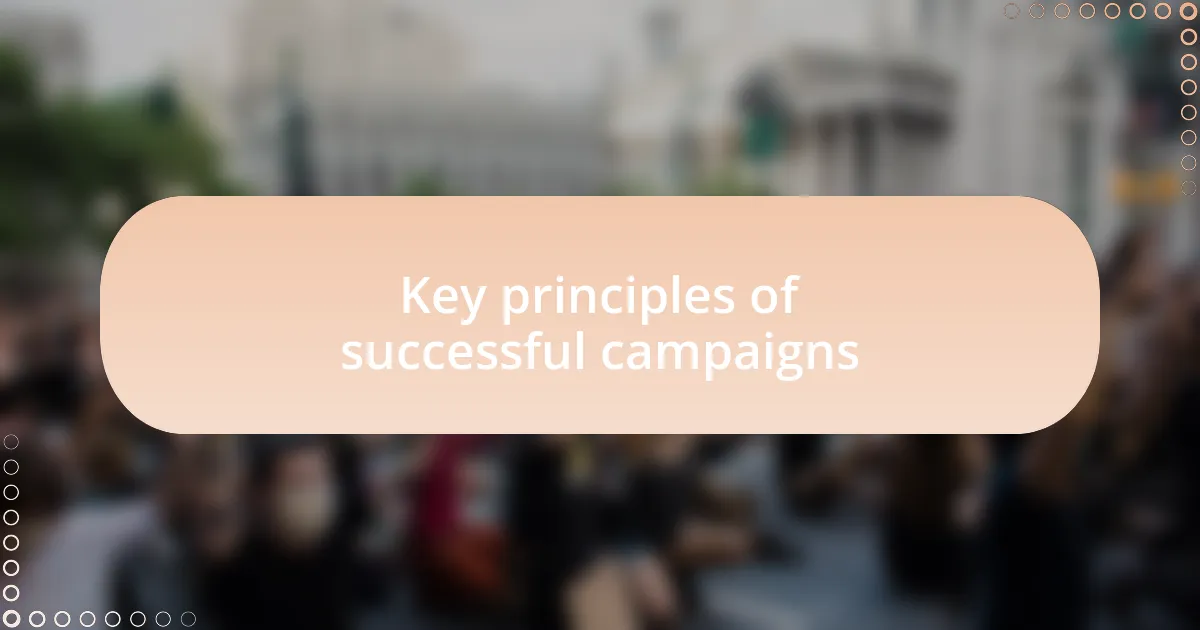
Key principles of successful campaigns
When organizing successful campaigns, one fundamental principle is clarity of message. I recall working on a campaign where we spent hours refining our slogan; it was amazing how a few well-chosen words could resonate so profoundly. A clear and compelling message not only attracts attention but also unites supporters under a shared purpose, making it easier for them to communicate the campaign’s goals to others.
Another key principle is the power of empathy. During a recent campaign, we focused on personal stories that highlighted the human costs of war. I realized that when we connect on an emotional level, people are more likely to engage and feel motivated to act. Isn’t it true that stories linger in our minds long after statistics fade? By sharing heartfelt experiences, we can inspire genuine advocacy and foster a sense of community among supporters.
Lastly, strategic collaboration can greatly amplify a campaign’s impact. I once participated in a joint effort with multiple advocacy groups; we pooled resources and reached a much wider audience than we could have alone. Have you seen how partnerships can create a ripple effect in awareness and action? By working together, we not only expand our reach but also demonstrate solidarity—an essential element in the fight for peace.
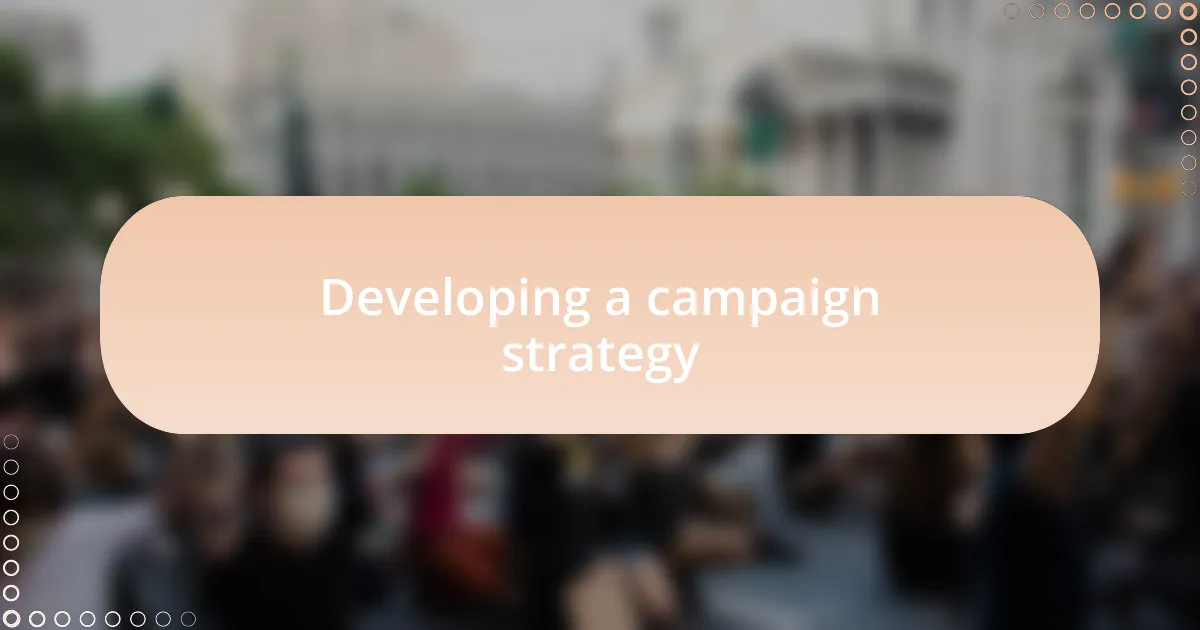
Developing a campaign strategy
When developing a campaign strategy, it’s crucial to set specific, measurable goals. I remember a time when our team aimed to raise awareness within our community about the impact of military spending. By defining clear objectives—like gathering a certain number of petition signatures—we not only focused our efforts but also created benchmarks to track our progress. This clarity helped rally our supporters and keep everyone motivated along the way.
Another essential element is understanding your target audience. Not too long ago, I found myself reflecting on a campaign that initially struggled to connect with young activists. By taking the time to really grasp their concerns and language, we adjusted our messaging. This shift opened up conversations that resonated much more deeply. Have you ever noticed how different demographics respond uniquely to various themes? Tailoring your approach to meet the audience where they are can significantly enhance engagement.
Finally, I cannot emphasize enough the importance of flexibility in your strategy. During a campaign advocating for peace, we encountered unexpected opposition that forced us to rethink our tactics. Adapting our approach allowed us to counter disinformation effectively and maintain our momentum. It’s interesting—how many times have you had to pivot in your plans? Embracing change and adjusting your strategy in response to real-time feedback can make all the difference in achieving your goals.
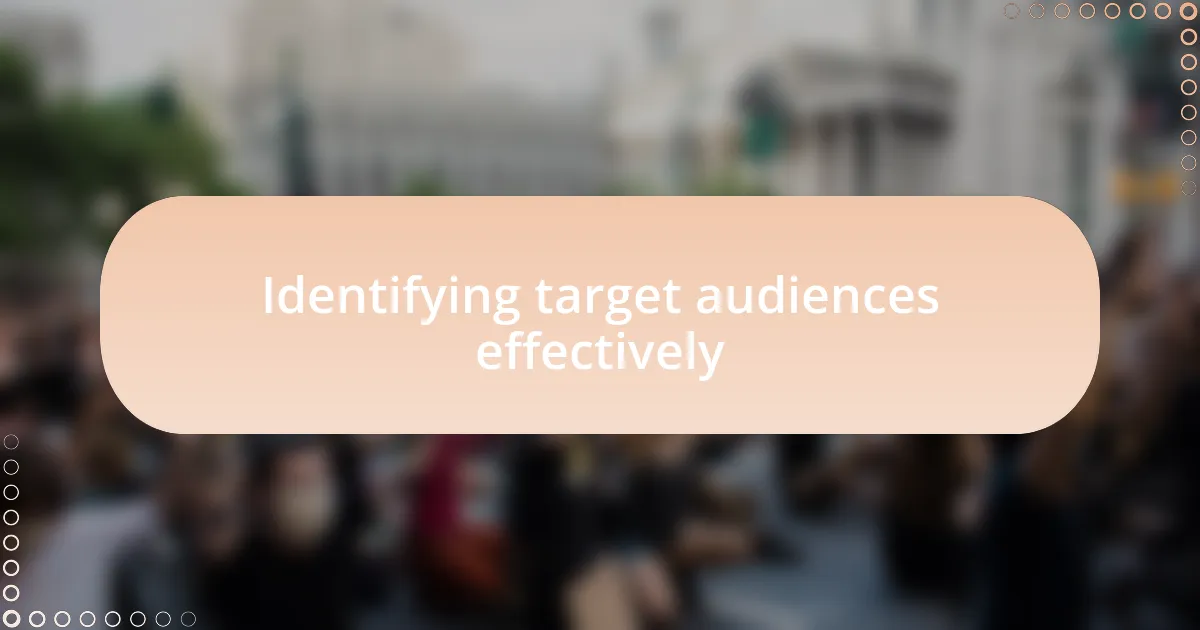
Identifying target audiences effectively
Understanding your target audience isn’t just about demographics; it’s about their values and emotions. I recall a campaign we launched against a local military recruitment center. It was eye-opening to discover that many young people were motivated not solely by anti-war sentiments but by a desire for social justice and equality. By aligning our message with their broader concerns, we fostered a stronger connection that transcended mere opposition to war. Have you considered what truly drives your audience beyond the surface-level issues?
In my experience, using focus groups can be invaluable when identifying your audience. During one campaign, we gathered a small group of individuals from various backgrounds to discuss their perceptions of our movement. Their insights were enlightening. For example, a participant shared how they felt disillusioned with activism due to past experiences. This feedback prompted us to develop more inclusive and supportive community events, ultimately widening our reach. Aren’t these conversations vital for shaping a message that resonates?
Finally, leveraging social media analytics helps define and refine your audience. I frequently analyze engagement metrics to understand which posts resonate most with my followers. It surprised me to see how certain themes evoke stronger reactions than others. By continuously assessing our audience’s responses, I can adapt our content to better engage and inspire action. Don’t you think tracking these patterns can lead to a more impactful campaign?
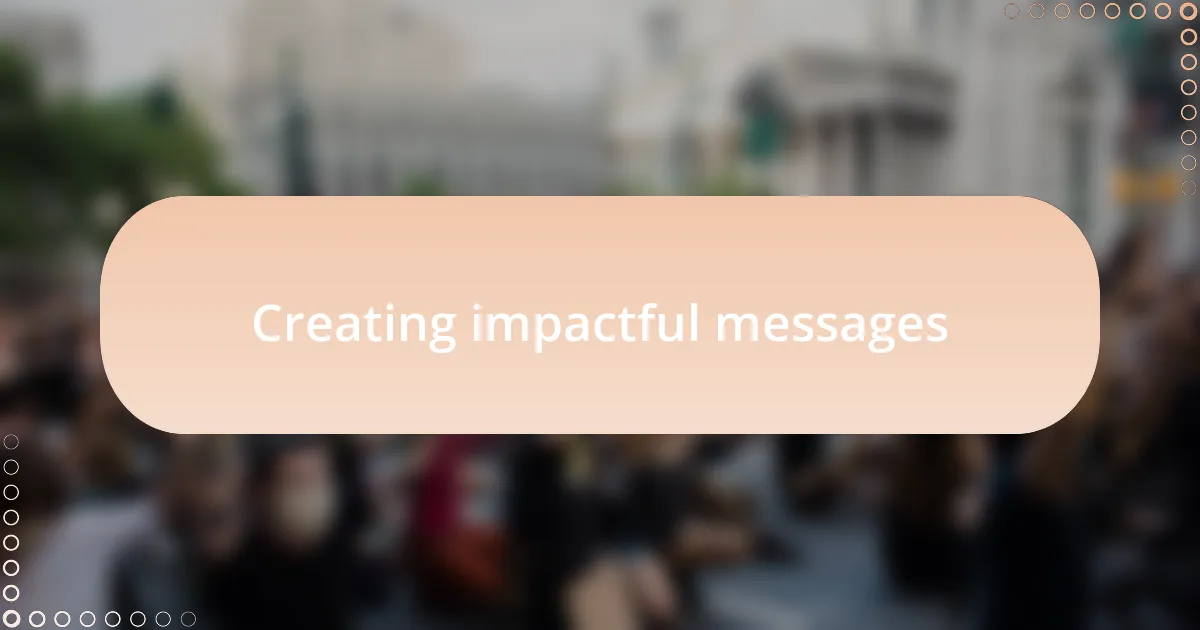
Creating impactful messages
Creating impactful messages requires a deep understanding of emotional triggers that resonate with your audience. I once crafted a message in a campaign focused on former soldiers advocating for peace. Their stories of struggle and resilience struck a chord with the community, turning abstract anti-war sentiments into visceral experiences. Have you thought about how personal narratives could amplify your message?
One key to impactful communication is storytelling. I remember a time when we shared a poignant video featuring a mother of a soldier who had returned home with visible scars. Her candid reflections on the price of war moved many more than statistics ever could. This type of messaging isn’t just informative; it connects on an emotional level, prompting viewers to contemplate the real consequences of conflict. How powerful do you think a single story can be in rallying support?
Lastly, it’s crucial to match your message’s tone and style to your audience’s preferences. I learned this during a campaign aimed at high school students. We shifted from formal presentations to dynamic, interactive workshops filled with music and art. The responses were immediate – students became engaged and passionate about the cause. Have you considered how adapting your message format can enhance connection and motivation?
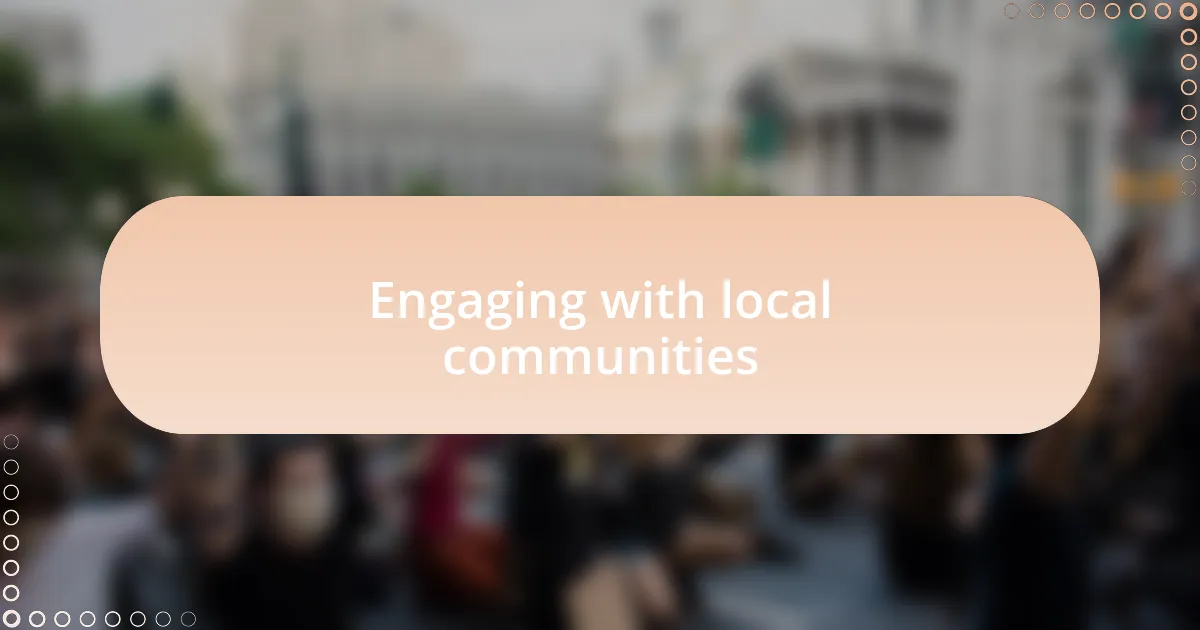
Engaging with local communities
Engaging with local communities starts with building trust and rapport. I recall organizing a community forum in a neighborhood deeply affected by military actions. By inviting local leaders and listening to residents’ experiences, I found that people were more willing to share their concerns and stories, creating a space that fostered understanding and collaboration. Have you ever seen how open dialogue can shift perceptions?
In my experience, hosting collaborative events, such as peace rallies or art exhibitions, can enhance community involvement significantly. At one event, local artists showcased work reflecting their views on conflict, which not only drew in residents but also sparked conversations about their own experiences. People felt seen and heard, and this sense of belonging galvanized them to participate more actively. Isn’t it fascinating how creativity can bridge gaps between people?
Moreover, leveraging social media platforms to highlight community voices can amplify the impact even further. I remember a campaign where we shared stories from residents about how war had personally affected them, creating a digital narrative that resonated with a broader audience. This approach not only engaged local communities but also attracted other supporters who empathized with their struggles. How do you think social media can be harnessed to enhance community engagement in activism?
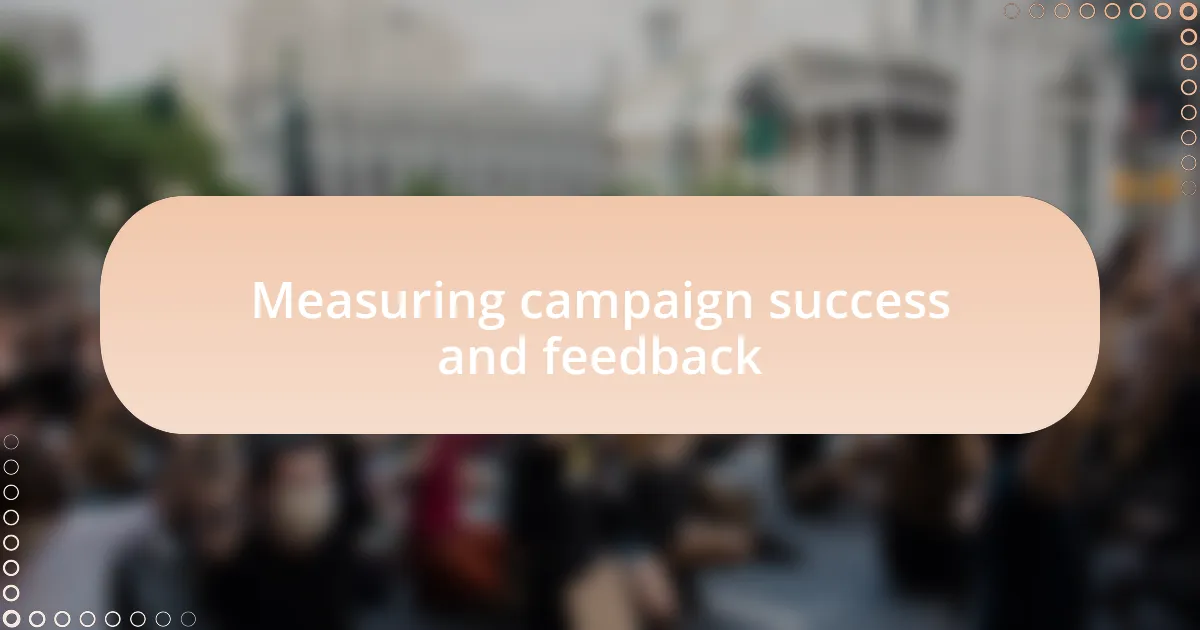
Measuring campaign success and feedback
When measuring the success of a campaign, I’ve found that qualitative feedback often reveals more than mere numbers. After implementing a recent anti-war initiative, I reached out to participants through surveys and personal interviews. The heartfelt stories shared with me highlighted the emotional impact the campaign had, much more than any attendance figures or social media metrics could convey. How often do we dismiss the power of personal narratives in understanding our influence?
In another instance, tracking engagement metrics on social media provided critical insights into our message’s reach. I noticed a spike in shares and comments during a live Q&A session with activists and community members. This real-time feedback not only demonstrated interest but also allowed us to adjust our messaging instantly, making it more resonant with our audience. Have you ever experienced such an immediate connection with your audience?
Additionally, reflecting on the overall mission and goals before launching a campaign is essential for effective measurement. I remember a time when we revisited our objectives midway through an ongoing project. This reassessment made it clear that our initial goals were not fully aligned with the community’s needs, leading us to pivot our strategy. How do you ensure that your objectives align with the voices of those you aim to represent?